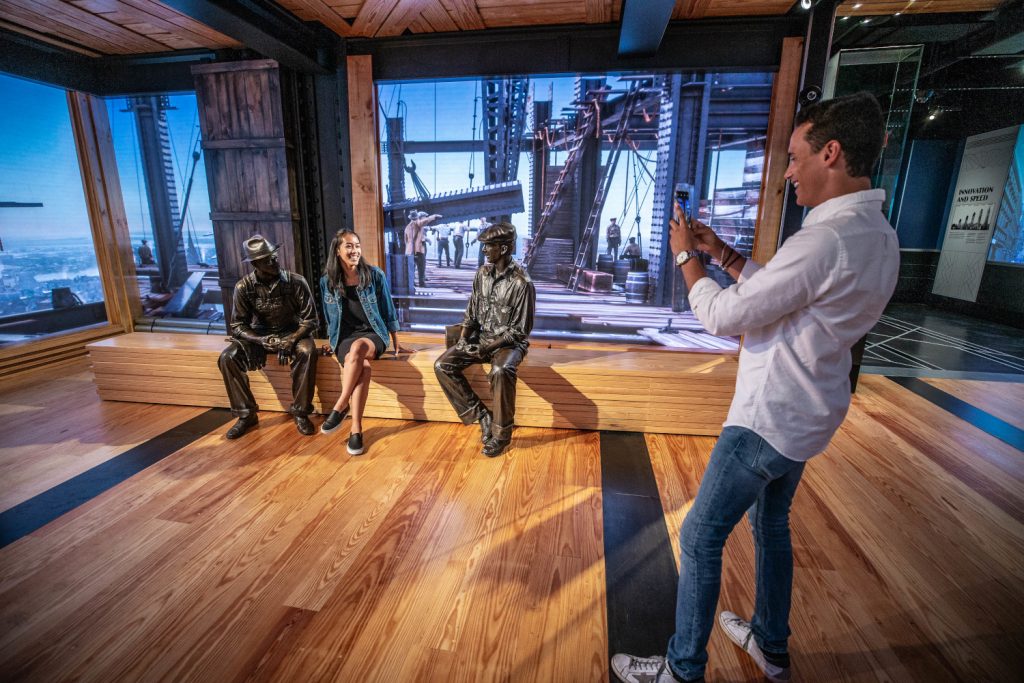It’s easy to make the case that the Empire State Building (ESB) is the world’s most famous building. Since it opened in 1931, the ESB has captured the American imagination and been a fixture in popular culture, having been featured in more than 250 movies and TV shows—from the iconic climax of the 1933 film “King Kong” (and its many remakes), to the nostalgiafest “Ready Player One,” to more lighthearted, schlocky fare like “Sharknado 2.” It is one of New York NY’s most famous attractions, with more than four million annual visitors. And its world-famous lights have commemorated countless holidays and world events, both tragic and triumphant.
The ESB recently underwent a largescale reimagining intended to transform the journey from its ground floor up to its world-famous observation decks into an interactive multimedia experience befitting such an iconic destination. AV technology solutions provider Diversified was contracted to bring the Empire State Realty Trust’s vision to life, which included the design and installation of several interactive museum-like exhibits celebrating the ESB’s history and its cultural significance.
The Diversified team for the project was led by Project Manager Travis Heitchew, Lead Engineer Aaron Hickman and Site Supervisor Aubrey Dover. Diversified worked in conjunction with general contractor Skanska, exhibit design firms Thinc Designs and kubik maltbie, and content creator Squint/Opera.
According to Diversified, using AV technology to curate a complete visitor experience from the entrance to the observation decks on the 86th and 102nd floors was one of the main goals of the project. “The preexisting experience was really just a queue; you were just waiting to get to the top. And, as exciting as the top is, and as incredible the view up there is, they wanted to make it a journey [to get there],” Hickman said. “So, in adding the museum exhibits that highlight aspects of the building and aspects of the culture, the hope was to be able to create a user experience that was a journey from the bottom to the top.”
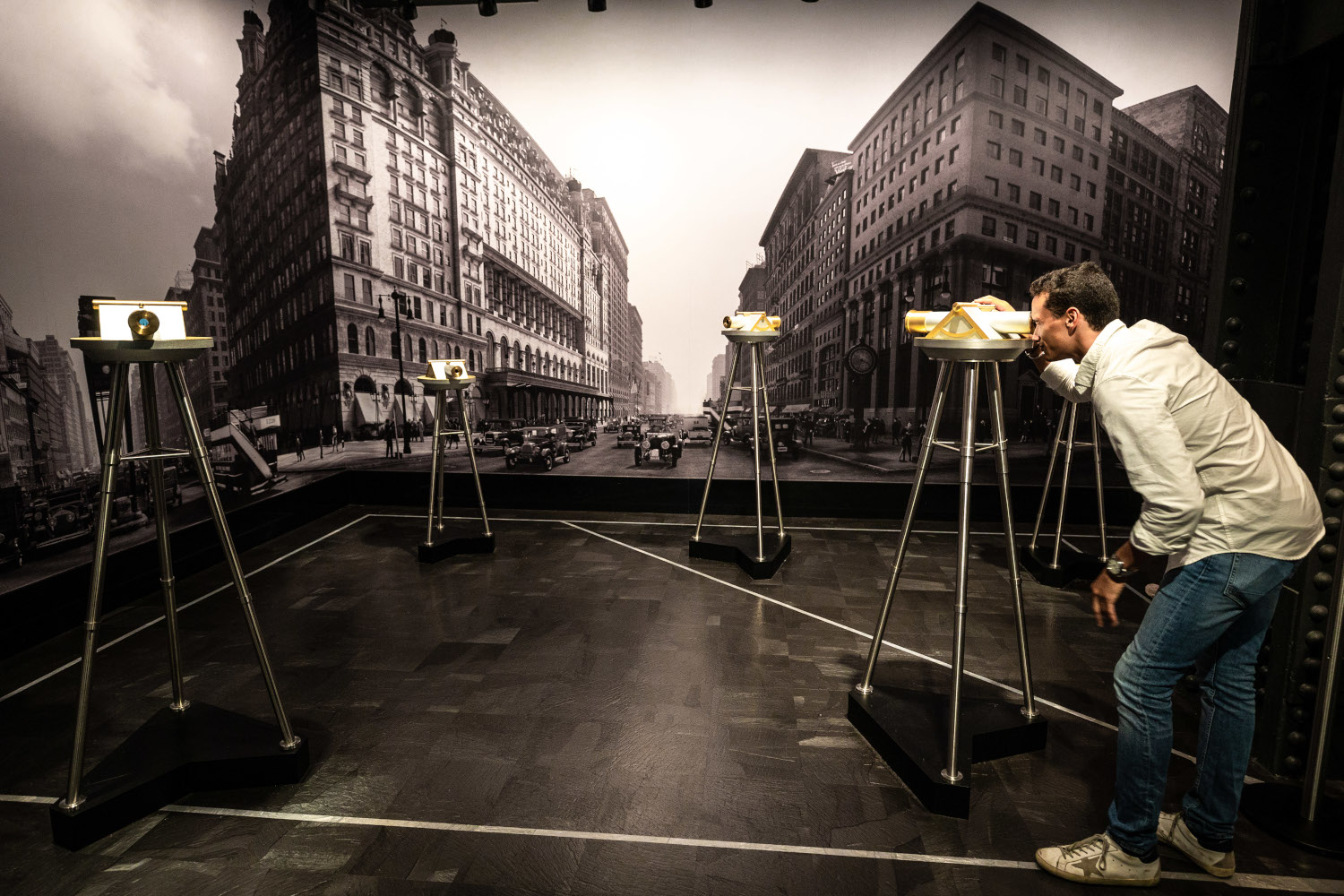
Wayfinding
From the moment visitors enter the ESB on the ground floor, the wayfinding system is there to guide them through the entire experience. “Wayfinding was something that was very much on the forefront of [the client’s] mind because in a typical museum setting, guiding the visitor to where they need to go can be a challenge,” Hickman said. “And there was a really strong emphasis on working with Squint/Opera to create both seamless technology and content playback that would show people where to go, without having to station docents throughout the space and put up temporary signs. So, we placed a combination of both static and dynamic signage on the walls and overhead, and then made sure that the content that was driving those signs was accessible.”
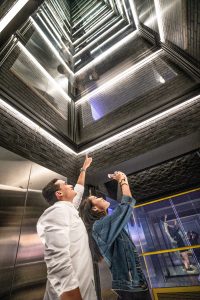
There are wayfinding displays peppered throughout the exhibit spaces, from the ground floor all the way up to the observation decks. Hickman described the wayfinding system in depth. “Embedded in the floor, there are lines that subtly show you where to go, and people actually intuitively follow them. The lighting overhead follows those same lines. So, it’s like it’s illuminating your path up,” he explained. “The overhead digital wayfinding and the wall wayfinding are in line with those paths to show you where to go. Overhead wayfinding is Planar TVH 1.6 LED, and wall wayfinding is Planar UR7551-MX-ERO LED. Both are enclosed in a custom enclosure that [mimics] the Art Deco style of the building and has arrows that point where to go. So, not only is it a dynamic piece of signage that has LED video showing information, but the physical housing of it is also telling you where to go.”
The content-delivery system for the wayfinding displays was built with redundancy in mind. “What’s driving those displays is a custom content-management system [CMS] that was created by Squint/Opera, and it’s being played out by a combination of BrightSign XD1033 static media players and HP Z2 workstations,” Hickman said. “The wall wayfinding, which are larger 4K canvases, have more dynamic content that’s sort of data driven, so they’re pulling data feeds in and modifying that content in real time. Those are driven by HP workstations that are running the custom application. And that’s all being played out through Extron video matrices individual to each exhibit.”
Hickman explained, “[That allowed us] to provide a high level of redundancy and robustness and modularity in the systems, so that if one display or one type of exhibit went down, it didn’t take out the whole system. And then each system has a primary and backup player. For instance, if you have two overhead digital wayfinders, that’s two primary players, and then you’d have a shared backup. If the primary element fails, it automatically fails over to the backup player. You have a seamless transition that is virtually invisible to the end user, [which is important] because nobody wants a black screen. That just looks wrong.”
Entrance & Security
In the entrance area, the visitors encounter their first exhibit: a celebration of the various celebrities and public figures who have participated in lighting ceremonies at the ESB. The ESB is world renowned for its illuminated peak, and the lights are frequently changed to different colors to mark holidays and major events. The “Lighting Ceremony” exhibit features a 4×4, 4800mm x 2700mm Planar TWA 1.2 videowall that displays images of past lighting ceremonies and the famous figures who have participated in them, as well as a Samsung PM32F display that shows information about the people depicted in the exhibit and the events they were on hand to commemorate. Dynamic content for this exhibit is driven by an HP Z2 workstation.
As visitors make their way through the entrance area and up the stairs to the second-floor gallery, they pass a two-story scale model of the ESB designed by famed model-maker Richard Tenguerian. They then enter the security line and ticket kiosk area, which features a number of 86-inch LG Ultra-Stretch digital signage displays that depict pictograms of items visitors are prohibited from bringing into the building, as well as other security information. (Because the ESB is an international attraction, pictograms were used as often as possible on the informational displays, although some information still had to be translated into an exhaustive list of languages.) Once visitors get through security, they are greeted by a three-projector blend that displays messages welcoming them into the exhibit area. “It’s three Panasonic PTRZ970 laser projectors, and they’re each WUXGA,” Hickman described. “It’s being driven by a Dataton WATCHOUT system.”
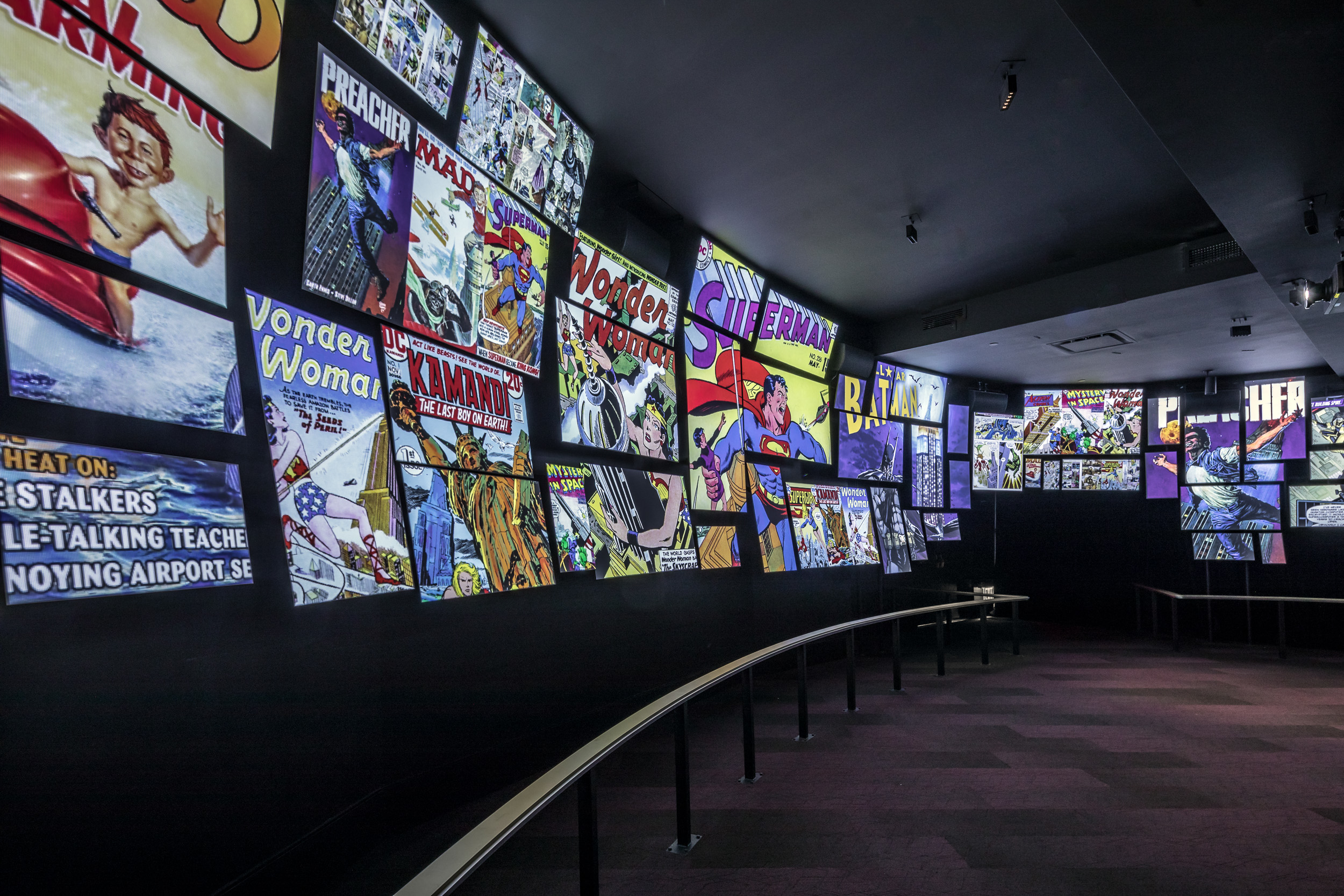
Journey Through Time
One of the largest features of the revamped ESB is the new second-floor gallery, which comprises 10,000 square feet of multimedia exhibits. The first, known as “The Site in the 1920s,” uses a variety of video technologies to depict the ESB building site during construction. It features a large projection on the left-hand wall that shows the ESB being built in time-lapse fashion; the imagery is provided by a Panasonic PT-RZ970 equipped with a short-throw lens that is fed via BrightSign XD1033 media player.
On the right-hand side, nine replica sitesurvey transits are angled toward different parts of a wall mural depicting the corner of 6th and 32nd as it looked in the 1920s. “These are replica site-survey transits that kubik maltbie created that have a monocular type of viewer,” Hickman described. “You can walk up to each of them and look through it. And embedded inside is an Ikan S7H seven-inch LCD that has some content on it. Each one of these nine viewers is positioned aiming at the wall, and the wall has a semi-panoramic scene of the corner of 6th and 32nd. The mural on the wall is static, but when you look through each one of these viewers, that image on the wall comes to life. Each of the viewers has an animation of the static scene that is taking place directly in line with that viewer.” The animations offer visitors a glimpse of 1920s New York street life.
“And what’s really neat about that exhibit is, overhead, there are four SoundTube RS600i speakers, and we’ve created a generative soundscape,” Hickman continued. “The content creators recorded a number of cityscape clips that sound just like the city. I believe there are eight clips that [are] shuffled and rotated around those four speakers, generatively. We have a couple of random number generators that are being driven by the QSC Q-SYS Ecosystem, and we loaded those clips into the Q-SYS Audio Core. We created four audio zones, and each one of those four zones gets anything between one and eight of those clips at any given time. So, it creates this completely generative soundscape by rotating the clips around, and bouncing them back and forth, and adding them and subtracting them between the different channels. If you stand in one spot, it doesn’t sound like a loop. It sounds like the city.”
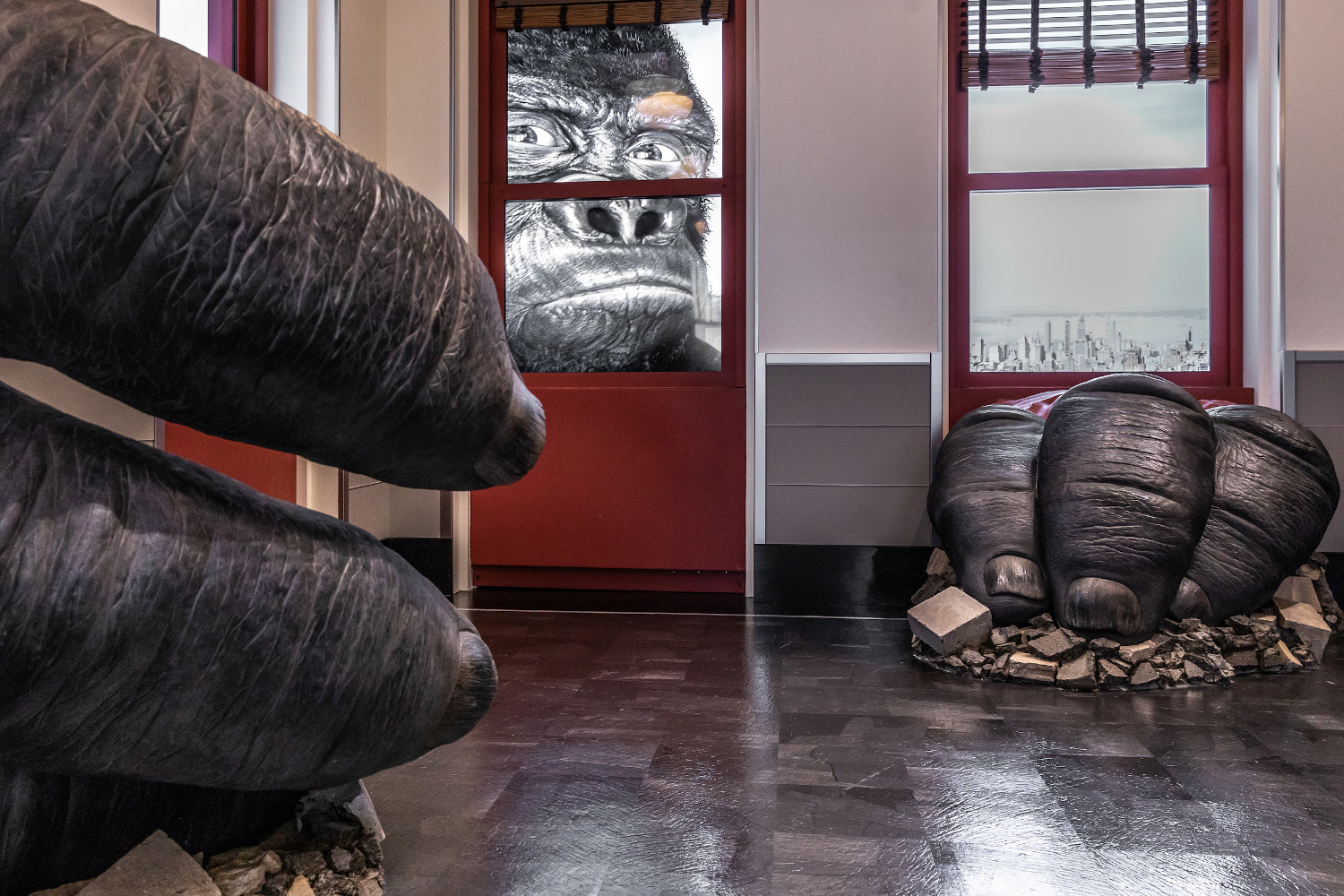
The next exhibit, known as “Construction,” was inspired by Lewis Hine’s iconic photographs of the workers at the ESB construction site. It essentially uses AV technology to recreate what it would have been like standing on one of the higher floors of the ESB as it was being built.
“This is a 360-degree immersive space that looks and feels like a construction site that would have existed on the higher floors of the building,” Hickman described. “All four walls are Planar CLI 2.6 LED with Stewart Filmscreen’s FideLEDy Vision diffusion product in front of them, because 2.6mm is a little bit of a coarse pitch [and] we wanted to kind of smooth that out. You’re surrounded by floor-to-ceiling LED walls. And then, in the ceiling, there’s more LED that’s partially occluded by crossing I-beams and crossing wooden planks. So, you get this feeling that you’re standing on one of the high-up floors in this construction zone. The content is imagery and scenes of what it would look like if you were standing on this floor of a construction site, with actors that were filmed and then superimposed on an animated set. So, it really feels like you’re in that space.” He added, “There are some benches made out of reclaimed timber that look like makeshift piles of wood and materials. And then there are life-size bronze figures throughout that area, replicas of individuals in poses like putting rivets into the steel I-beams or eating their lunch, those kinds of things. So, people can go in there and take pictures with the bronze statues.”
The “Construction” exhibit also has its own soundscape, although it is not generative. Eight Tannoy CMS503DCLP speakers play out an audio track that complements the animations on the videowalls wrapping around the room. “It’s an eight-channel system, and it was recorded with an eight-channel rig,” Hickman said. “It was recorded in a space similar to the size of the exhibit, with similar spacing of the speakers. So, it does have specialization in the sense that when it was mastered, sounds were placed in certain areas.”
Just beyond “Construction” is the “Opening Day” exhibit, which features another Planar CLI 2.6 LED wall with Stewart Filmscreen diffusion depicting an old-timey newspaper boy heralding the opening of the ESB in 1931. “That is also an actor that was filmed and then superimposed on a digital set. He’s standing on the corner saying [things like], ‘Come see the Empire State Building! Come see the observatory!’ It’s like it would have been on the day that it opened,” Hickman explained.
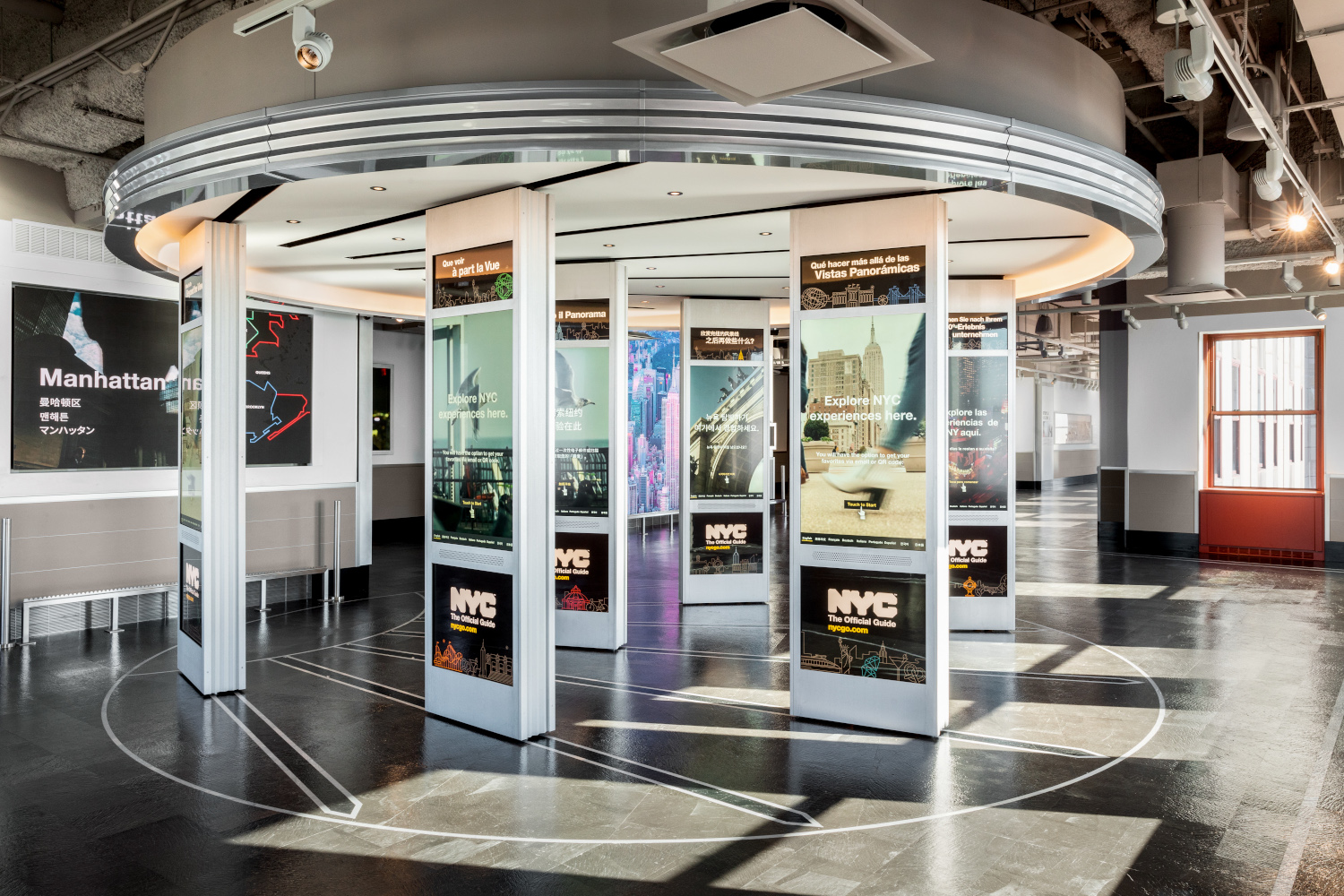
The Inner Workings
The next exhibit, “Modern Marvel,” shows how the ESB has evolved to meet the sustainability needs of the modern day. Five Planar EP5014K displays are mounted above five MultiTaction MT556XNB displays in the left-hand wall; the Planar screens depict facts about the ESB’s sustainability efforts in a variety of languages, and the MultiTaction screens offer interactive effects that help visitors engage more deeply with the information.
Just beyond “Modern Marvel” is the “Otis Elevators” exhibit, which is a tribute to the ubiquitous elevator company’s contributions to the ESB throughout the years, as well as a behind-the-scenes look at the elevators that service the 102-story building.
“Otis Elevators were the ones who built the elevators in the building originally, and they still maintain them to this day,” Hickman said. “There is a replica of one of the original elevator cabs that you can walk into, and it has a 98-inch Planar UR9851- ERO display embedded in it. So, you walk in, and it plays an animation that shows you going up through the floors. In addition, kubik maltbie restored some of the original governors and flywheels that controlled and activated those elevators. [The exhibit is] triggered by a proximity sensor, and, when that proximity sensor triggers, the media plays back on the screen; then, above this fake elevator cab, these governor wheels and pulleys start moving. And next to it is a switch-relay panel like the ones that actually powered these elevators. So, the switches and the relays move and light up.” Hickman added, “They actually used to spark. They don’t spark now. They just have LED elements in there that light up and make them look like they’re sparking.”
A Dakota FA-501 speaker embedded in the ceiling of the elevator cab plays out audio content to match the onscreen content, and the “sparking” of the switch-relay panel also has some associated audio.
Hickman elaborated further on how Diversified worked with kubik maltbie to program the motion-triggered aspect of this exhibit. “We’re taking a trigger from the proximity sensor that’s being passed through an Arduino controller that’s driving the lighting effects and the switch relays and the governors,” he said. “[kubik maltbie’s part of the system is] processing that signal, they’re giving us a closure, we’re taking that closure in, and passing that through our Q-SYS system to then trigger Dataton WATCHOUT to play back the video clip, as well as the audio.
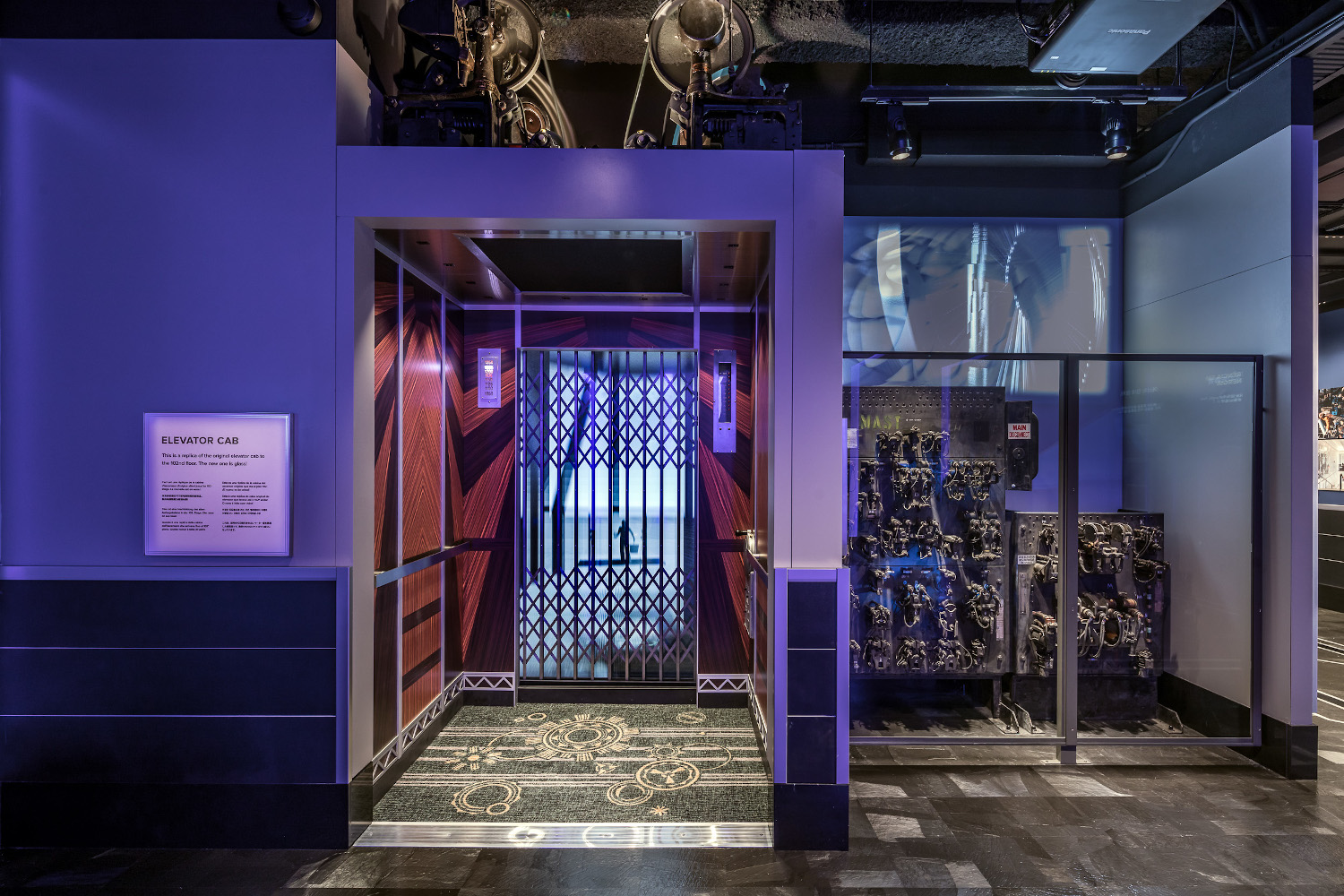
The elevator exhibit also features another 4D multimedia experience. “The idea is that this exhibit is showing what an elevator bank would look like in service mode,” Hickman explained. “It’s a replica of a three-bay elevator shaft that you can walk through. And in the middle of it, there is a mirror box that kubik maltbie designed, so you can look up and down and it looks like this infinite elevator shaft as you’re walking through it.” He continued, “When you walk in, there’s a two-way mirror on the left and on the right, floor to ceiling. And behind each two-way mirror is Planar CLI 2.6 LED. Those LED walls are playing what looks like elevators flying up and down, passing you. And then, to add to that, as those cars pass, we’ve synchronized the media with two effects: pneumatic solenoid-driven compressors, or air blowers, and acoustic transducers embedded in the diamond-plate floor. As the cars are flying by, the media is synchronized with the Q-SYS system to drive low-frequency effect into these transducers and send a closure out to the solenoids to drive the compressors to blow air at you. So, when an elevator passes you, you kind of get this rumble and a blast of air.”
According to Hickman, spacing in this part of the exhibit area was tight, so Diversified had to devise some ingenious rigging methods involving false walls and overhead rails that would allow system components to slide out into a service area when they needed maintenance. “One of the challenges [with the infinite-shaft exhibit] was the location of it,” he recalled. “It butted up right against another exhibit on the back side of it, the south side. And in order to [provide service access to] the LED, because it was pushed up against this two-way mirror that you can’t really remove, that product is front-service product.”
Hickman continued, “We actually had to put in an overhead trolley rail to service that LED. The LED is hung from above on this rail, and on the north side, you kind of just pull it back into this little service area away from the two-way mirror, and it rides along this trolley, this overhead I-beam. But on the south, because it abutted back up against another exhibit, that exhibit’s wall is actually a false wall that’s suspended from the same rail. And so you pull that wall back into the hallway to get access to behind the LED wall. And then you pull this LED curtain back, and you can get access to the front of it between the glass and the LED.” All the rigging for the LEDs throughout the ESB was provided by rp Visual Solutions; Chief provided the rest of the display mounts.
Upon leaving the elevator exhibit, visitors make their way through “Urban Campus,” which highlights some of the high-powered tenants of the ESB’s office floors, such as LinkedIn, Shutterstock and Expedia Group.
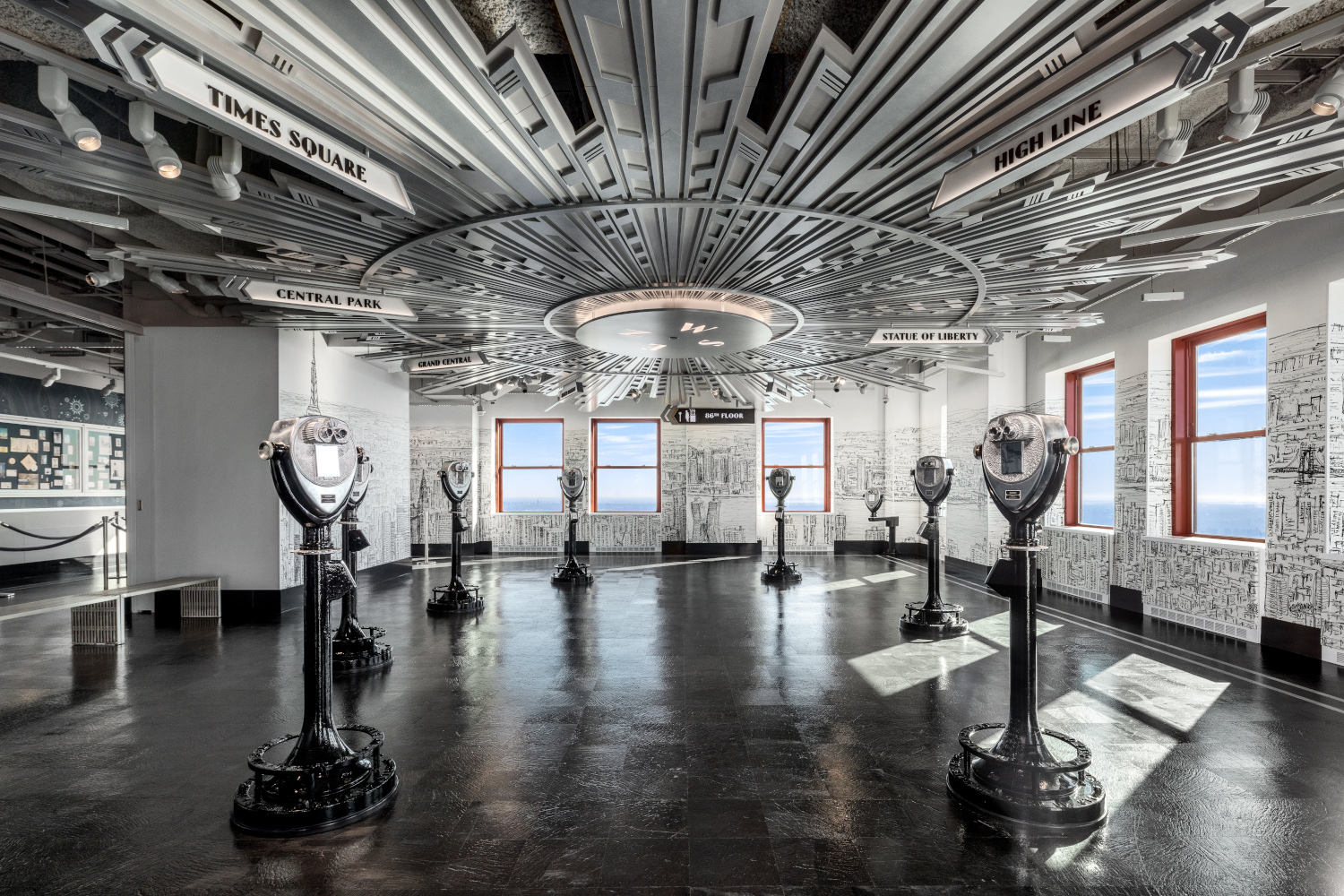
Pop-Culture Icon
Next up is “World’s Most Famous Building,” which celebrates the ESB’s many appearances in film, television and other media. The exhibit is essentially a blackout space illuminated by a moving collage of images projection mapped onto an array of rectangular surfaces lining the walls. Visitors are awash in nostalgic scenes like Spider-Man web-slinging his way around Manhattan and Little Mac from “Punch- Out!!” jogging in his pink sweats; the ESB looms large in every clip.
“It’s a four-projector blend on a two-axis, curved, concave surface, but it’s a faceted surface,” Hickman described. “We went with Green Hippo as the playout and mapping engine because of their ability to do complex 3D geometry and warping, import custom UV meshes and have a consistent primary and failover redundancy. The display technology is Panasonic PT-RZ970 projectors, the same ones that we’re using everywhere else. Those have the ET-DLE060 short-throw lenses.” The display surfaces are MDF board painted with Screen Goo. An original audio score plays over six Community IC6-2082/26 speakers hidden in the shadows between the display surfaces.
According to Hickman, the projection-mapping setup ended up being a much more practical solution than what was originally planned. “The original concept was to have upwards of 75 various-sized LCD screens in different orientations, ranging from five inches all the way up to 75 inches,” he said. “It was a great concept, but it would be an enormous lift to be able to do that, in terms of installation, service and the amount of pixels that you’d have to drive. So, when we got onboarded, we looked at that and we raised these flags and said, ‘We think this might be better served as a projection map.’ And we did a proof of concept in our demo lab to show the client that we could do a projection map onto these multifaceted surfaces and mask out the in-between.”
Next up is a tribute to the ESB’s first and most iconic appearance on the silver screen: Visitors turn the corner and come face to face with Kong, “the Eighth Wonder of the World” himself, as he begins his tragic climb to the ESB’s peak. The appropriately named “King Kong” exhibit marries AVL with animatronics to provide visitors with an irresistibly Instagrammable photo op: They can even stand in for Fay Wray in the clutches of Kong’s mighty grip. According to Heitchew, the line for Kong selfies can get rather long.
“In this room, we have nine 98-inch Planar displays being powered by Alcorn McBride players,” Heitchew said. “We’re syncing all the content between all nine screens. You’ve got airplanes that fly by. King Kong goes from window to window. We also sync the lights—they flicker when he sneezes. And the hand twitches and vibrates, also. And that’s all being triggered off the Q-SYS system.” He continued, “Speaker-wise, you’ve got Dakota Audio MA5s—inside each one of the radiators, there’s a small speaker. And then, in the wall, you’ve got four Sonance IS4 C speakers.”
Beyond “King Kong” and down a corridor lined with images of the celebrities who have visited the ESB throughout the years, visitors can take the elevators up to the 80th-floor exhibits. On the 80th floor, one of the first exhibits visitors encounter is “NYC: Above and Beyond,” which features seven MultiTaction MT556XNB interactive kiosks. “This is a highly interactive area where people can plan their trip to New York City, to other sightseeing places, and get their itineraries printed,” Heitchew said. “The Multi-Taction blades actually move on a track. So, if they needed to be pushed out of the way for an event, you can slide everything back and forth.” To help tourists plan their trips, a Planar DL2 1.5 LED display on the wall shows prerecorded content about New York’s various attractions and the many culinary options available.
In the nearby “Artistry in Light” exhibit, a documentary about the ESB’s famous lighting ceremonies loops on four Planar displays. The displays are all playing synced content from Alcorn McBride media players, while synced audio plays via overhead Dakota FA-501 speakers. Also nearby is “Most Photographed,” which is essentially a 4800mm x 3375mm LED wall depicting a slideshow of famous and award-winning photographs of the ESB. “This is the exact same Planar TWA1.2 display that was downstairs in ‘Lighting Ceremony.’ It’s just one row bigger on the top,” Heitchew said. A single overhead Dakota FA-501 speaker handles the audio for this exhibit, and a Samsung PM32F display placed to the side of the LED wall provides information about the photographs.
Beyond there is the Stephen Wiltshire exhibit. Wiltshire, an artist known for his photographic memory and incredible landscapes, famously completed an 18-foot panorama drawing of New York City from memory after a 45-minute helicopter ride. This exhibit features a recreation of Wiltshire’s drawing on the wall, as well as a documentary about Wiltshire’s art that plays on a 75-inch NEC X754HB high-brightness display.
The Wiltshire exhibit features a high-brightness display because the 80th floor has a lot of windows, and that particular display is located in an area that is highly prone to glare. This was just one of the ways Diversified addressed the unique lighting profile of the 80th floor. “We had Buro Happold come in and do a light study on this floor,” Heitchew explained. “Having them do that light study was a key part of being able to select the right programing and technology for the 80th floor.”
Heitchew continued, “One of the cool things we have on the 80th floor is called Night Mode. We’re looking at an astronomical clock, and, whenever sunset hits on the Empire State Building, all the screens on the 80th floor dim. That way, we don’t take away from the sunset view outside, and we don’t get glare off the windows. It’s actually really cool to be in there right when sunset hits and watch everything—the lights change, the content changes and so does the brightness of the screens.”
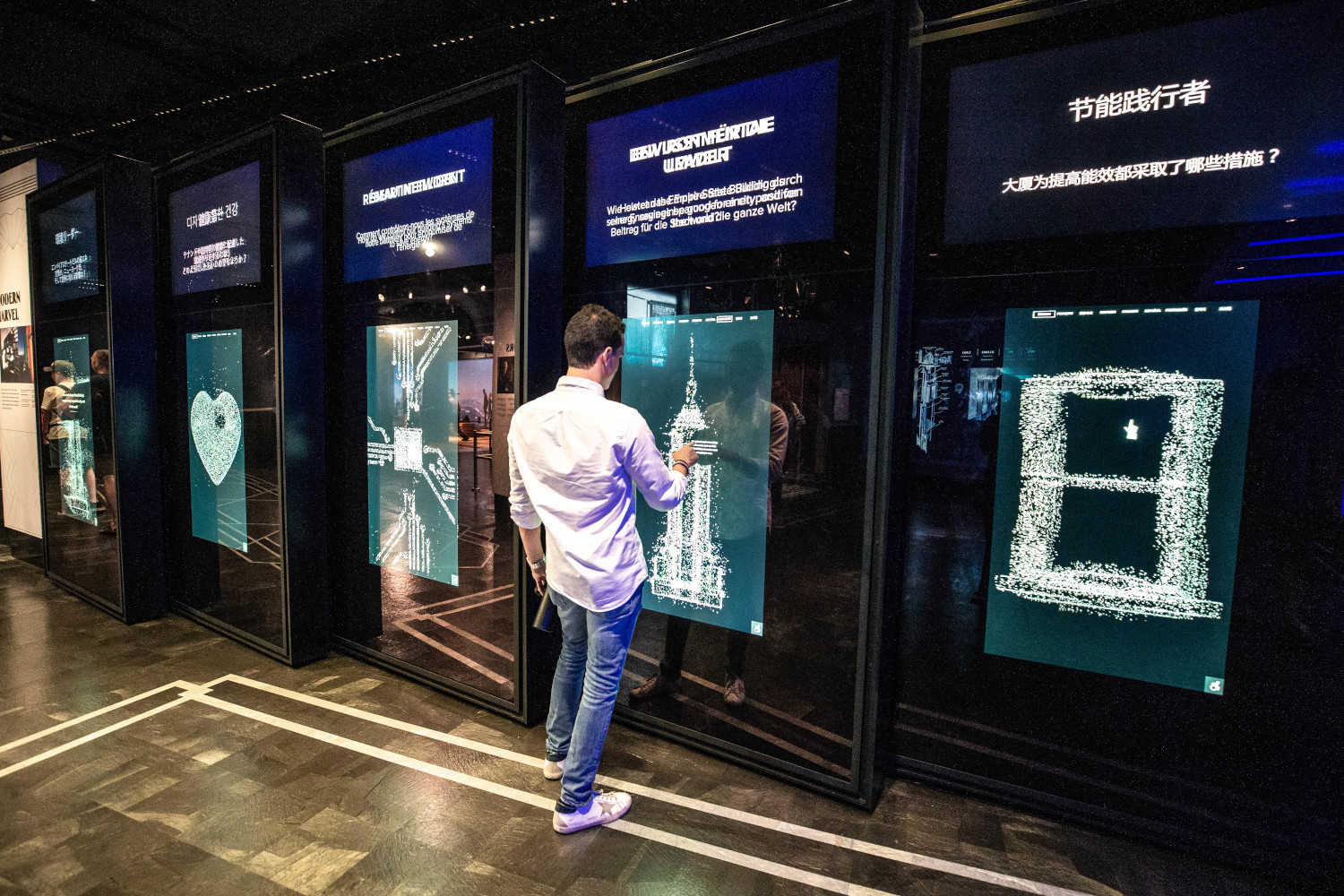
The marquee exhibit on the 80th floor is called “Scenes of NYC.” It features seven tower viewers—the type typically found at the top of tall tourist attractions—manufactured by Tower Optical Company. Much like the site-survey transits on the second floor, each of these tower viewers actually has an Ikan S7H seven-inch LCD screen inside it. The viewers are all oriented toward famous New York landmarks, and, when visitors look through them, the screen inside displays a view of the landmark as if the visitor were looking at it through binoculars. This exhibit was also a close collaboration between Diversified and kubik maltbie.
“The cool thing is, kubik maltbie put Arduino boxes in there, so we’re measuring the amount of the turn and the pivot up and down. And Squint/Opera programmed the content so that it tracks with that. So, it’s not like you’re just looking at a flat image when you look through the viewer. You can pan and tilt the image, and it moves with you,” Heitchew said. “There are also speakers [embedded in the viewers]. So, when you walk up to the eyepiece, you’re not only seeing but [also] hearing what you’re looking at. It’s almost like a version of VR.”
Wrapping up the 80th floor is “Share Your Experience.” Four 75-inch Planar UR7551-MXTOUCH touchscreen displays are mounted within archways along the hallway, and visitors can post their pictures and selfies to social media with #EmpireStateBuilding to see their pictures pop up on these displays. “We have both touch capabilities here and two Intel RealSense D435 depth cameras. If you’re within a three-foot radius, the monitor reacts to you as you’re walking by. So, it kind of draws you back over to it and says, ‘Hey, come interact with me!’” Heitchew said. “We’ve got HP Z8 computers with very high-end graphics cards running that, and we’re processing a ton of data.”
From there, the only things left on the ESB tour are the 86th- and 102nd-floor observation decks. However, the views up there don’t need any AV assistance to create an unforgettable experience.
Heitchew wrapped up our discussion of the ESB upgrade by describing the control system, as well as how the system is operated and maintained. “About 90 percent of the control is show control going through Medialon and Q-SYS,” he said. “Q-SYS is our audio, which talks to Medialon via triggers, triggering different audio or video events to happen. The building is staffed with onsite AV technicians who have the ability, through iPads and Medialon web panels, to control the system from anywhere in the building.”
He continued, “There are four rack rooms of equipment that control all this. We’re on the building’s network. We’re not on a segregated AV network, but we have about six virtual local area networks [VLANs]—everything from control VLANs, to audio VLANs, to video VLANs. We also installed 32 Avigilon cameras that we use for monitoring the exhibits. And everything has a backup, as far as critical-path items, like playback engines and the CMS. If one of the HP machines were to fail or the CMS were to fail, we’re monitoring the heartbeats of all this equipment, and within 10 seconds of failing, it would automatically switch to a backup player so the screens wouldn’t go dark.”
All told, this was a memorable project for Diversified, and the team couldn’t have asked for a more amazing job site. “We can attest to the views up there,” Heitchew shared. “Almost every night—especially in the winter, around 4 o’clock, when the sun starts setting, and there was nobody up there except us—you’d kind of stop working, because every day was a different sunset. It was pretty cool.”
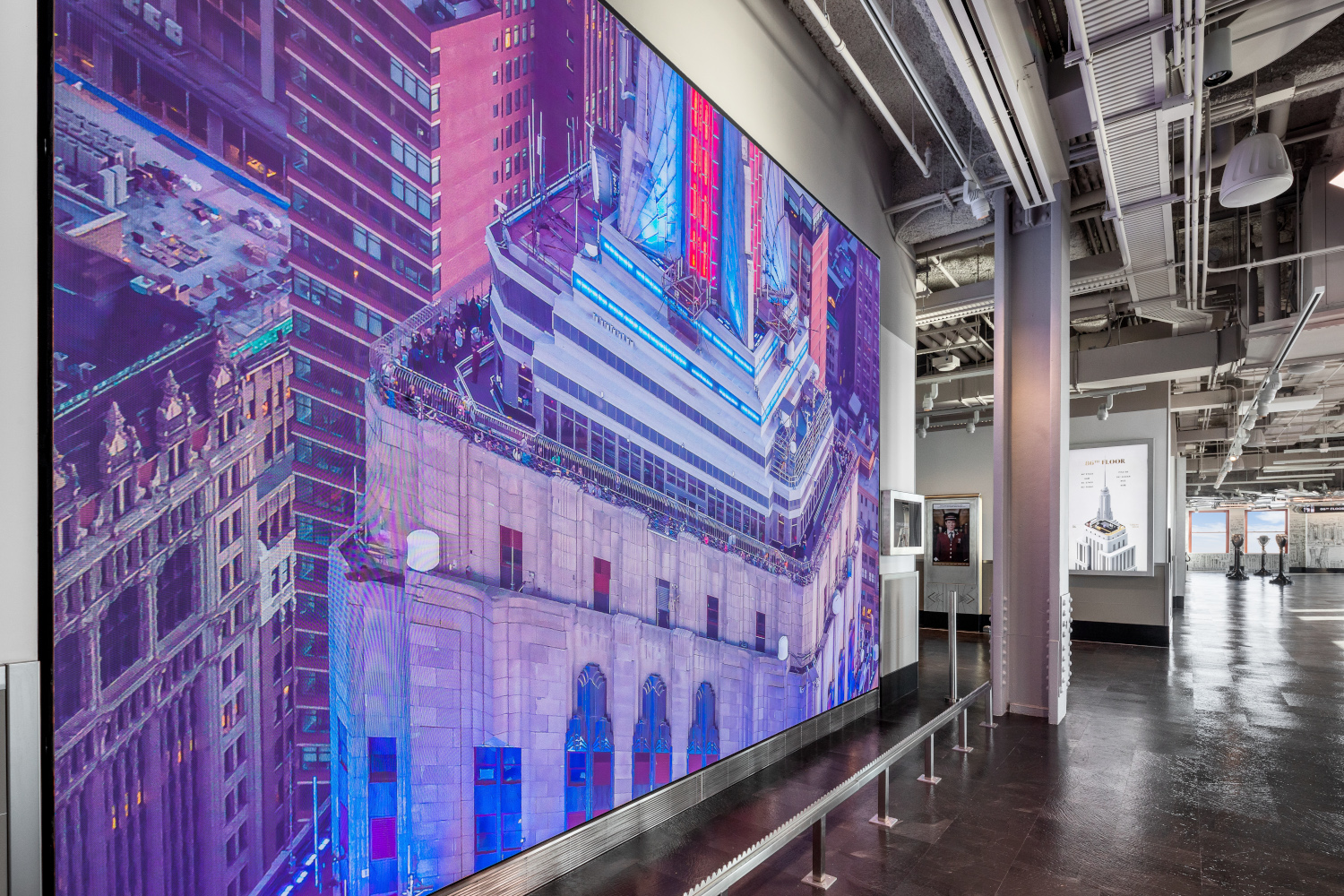
For a walkthroughs of the revamped Empire State Building’s second-floor and 80th-floor exhibits, click here. To view more installation features from Sound & Communications, click here.
